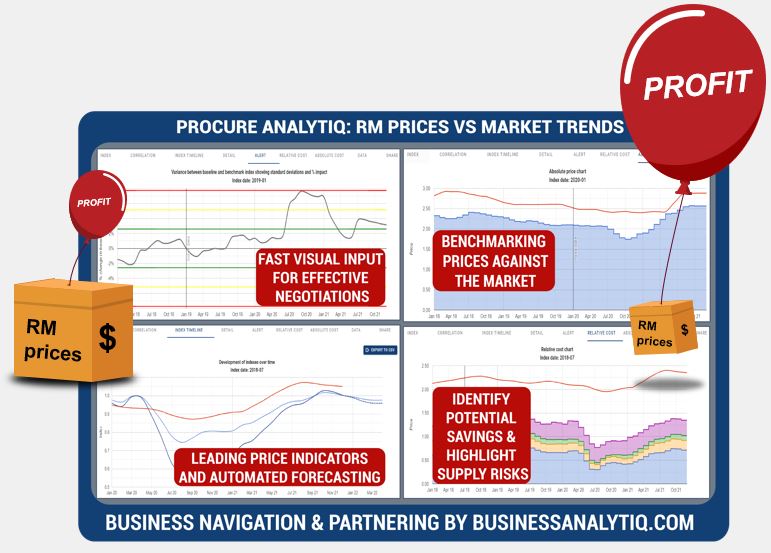Ammonium nitrate price April 2024 and outlook (see chart below)
- North America:US$0.31/KG, unchanged
- Europe:US$0.35/KG, unchanged
- Africa:US$0.52/KG, 2% up
- Northeast Asia:US$0.51/KG, unchanged
- South America:US$0.34/KG, 3% up
Business Analytiq assumes no responsibility or liability for any errors or omissions in the content of this site. The information contained in this site is provided on an “as is” basis with no guarantees of completeness, accuracy, usefulness, or timeliness.
Ammonium nitrate price index
This post is a summary of the ammonium nitrate price developments. The price developments of ammonium nitrate are expressed in US$ prices converted FX rates applicable at the time when the price was valid. Ammonium nitrate price index developments are calculated from multiple separate sources of data to ensure statistical accuracy.
The outlook for ammonium nitrate prices, on the second tab, is generated from different inputs including:
- Very recent price developments of immediate cost drivers of ammonium nitrate prices
- Recent price developments of underlying feedstocks which drive the price of ammonium nitrate
- Market futures for both cost drives and feedstocks of ammonium nitrate prices
- Adjustment of current supply/demand imbalances in the ammonium nitrate market
- Longer term trends in likely demand conditions
Further information on the Ammonium nitrate price index
What is ammonium nitrate
Ammonium nitrate is a chemical compound with the formula NH4NO3. It is a white crystalline solid that is highly soluble in water. Ammonium nitrate is commonly used as a fertilizer and as an ingredient in explosive mixtures.
As a fertilizer, ammonium nitrate provides a source of nitrogen that can be easily absorbed by plants. It is a popular choice for many farmers and gardeners because of its high nitrogen content and relatively low cost.
Ammonium nitrate is also used in the production of explosives, such as in mining and construction. When mixed with fuel oil, it forms a highly explosive mixture that is commonly known as ANFO (ammonium nitrate fuel oil). ANFO is commonly used in blasting operations to break up rock and soil.
However, ammonium nitrate is highly reactive and can be dangerous if not handled properly. It has been involved in several major industrial accidents, including the explosion in Beirut in 2020, which killed over 200 people and injured thousands more.
How is ammonium nitrate produced
Ammonium nitrate is produced by combining ammonia gas (NH3) and nitric acid (HNO3) in a reactor vessel. The reaction between these two chemicals produces ammonium nitrate and water (H2O) as byproducts:
NH3 + HNO3 → NH4NO3
The reaction is exothermic, meaning it releases heat, and the temperature of the mixture can increase rapidly. To control the temperature and prevent a runaway reaction, the production process typically involves adding the nitric acid slowly to the ammonia, while cooling the mixture with water or refrigerant.
The resulting ammonium nitrate solution is then evaporated and crystallized to produce solid ammonium nitrate. The crystals are typically sorted by size and screened to remove any impurities. The final product is a white crystalline solid that is typically sold in granular or prilled form.
It’s worth noting that the production of ammonium nitrate should be done with caution, as the process can be hazardous due to the high reactivity and potential for explosions. Proper safety measures must be taken to ensure the safety of workers and the surrounding environment.
What are the key feedstocks of Ammonium nitrate
The primary feedstocks for Ammonium nitrate are Ammonia Gas and Nitric acid
The production of ammonia gas are natural gas and steam. In a process called the Haber-Bosch process, natural gas (which is mostly methane, CH4) and steam are reacted together in the presence of a catalyst to produce hydrogen gas (H2) and carbon monoxide (CO), which are then reacted with nitrogen gas (N2) from the air to produce ammonia (NH3):
N2 + 3H2 → 2NH3
The ammonia produced in this process is typically purified and compressed to produce ammonia gas, which can then be used as a feedstock for other chemical reactions.
The primary feedstock for the production of nitric acid is ammonia gas. In the Ostwald process, ammonia is oxidized to produce nitric oxide (NO), which is then further oxidized to produce nitrogen dioxide (NO2):
4NH3 + 5O2 → 4NO + 6H2O
2NO + O2 → 2NO2
The nitrogen dioxide is then absorbed in water to produce nitric acid:
3NO2 + H2O → 2HNO3 + NO
So, in summary, the feedstocks for the production of ammonium nitrate are natural gas and air (for the production of ammonia gas) and ammonia gas (for the production of nitric acid).
What is ammonium nitrate used for
Ammonium nitrate has a variety of uses, including:
Fertilizer
Ammonium nitrate is a common source of nitrogen in fertilizers, which are used to promote plant growth. The nitrogen in ammonium nitrate is easily absorbed by plants, making it an effective fertilizer.
Explosives
Ammonium nitrate is a key ingredient in many explosives, including the commonly used ANFO (ammonium nitrate/fuel oil) mixture. ANFO is widely used in mining, quarrying, and construction to break up rocks and soil.
Cold packs
Ammonium nitrate can be used to make cold packs. When mixed with water, the reaction is endothermic, which means it absorbs heat, causing the pack to become cold.
Food preservation
Ammonium nitrate is sometimes used as a food preservative to prevent spoilage.
Gas storage
Ammonium nitrate can be used to store gas, such as hydrogen, as a solid.
Wastewater treatment
Ammonium nitrate is sometimes used in wastewater treatment plants to remove pollutants from water.
Which countries produce the most ammonium nitrate
According to the latest available data, the countries that produce the most ammonium nitrate are:
China
China is the largest producer of ammonium nitrate in the world, with an estimated production of over 17 million metric tons in 2019.
Russia
Russia is the second-largest producer of ammonium nitrate, with an estimated production of over 6 million metric tons in 2019.
Ukraine
Ukraine is the third-largest producer of ammonium nitrate, with an estimated production of over 4 million metric tons in 2019.
United States
The United States is the fourth-largest producer of ammonium nitrate, with an estimated production of over 3 million metric tons in 2019.
Canada
Canada is the fifth-largest producer of ammonium nitrate, with an estimated production of over 1.5 million metric tons in 2019.
Other major producers of ammonium nitrate include India, Indonesia, Brazil, and Australia.
How big is the ammonium nitrate market
The global market for ammonium nitrate is significant, with an estimated value of over USD 20 billion in 2020. The market is driven primarily by the use of ammonium nitrate as a fertilizer, as agriculture is the largest end-use industry for ammonium nitrate. The demand for ammonium nitrate as a fertilizer is expected to continue to grow, as the global population increases and demand for food rises.
In addition to its use as a fertilizer, ammonium nitrate is also used in the mining and construction industries as an explosive, as well as in the production of cold packs, food preservatives, and other applications.
The market for ammonium nitrate is highly competitive, with many major players in the industry, including Yara International ASA, EuroChem Group, CF Industries Holdings Inc., Orica Limited, and others. The market is also affected by factors such as regulations, trade policies, and global economic conditions.
According to https://oec.world/ :
Ammonium nitrate, including solution, in pack >10 kg are the world’s 1266th most traded product.
In 2020, the top exporters of Ammonium nitrate, including solution, in pack >10 kg were Russia ($644M), United States ($105M), Bulgaria ($89.9M), Lithuania ($89.4M), and Georgia ($80.4M).
In 2020, the top importers of Ammonium nitrate, including solution, in pack >10 kg were Brazil ($245M), Romania ($75.4M), Canada ($70.7M), India ($62.7M), and United Kingdom ($61.5M).
Further reading
Business Analytiq
BE THE FIRST TO SEE RISK AND OPPORTUNITY!
BusinessAnalytiq provides unlimited market trend data and an online tools to track market developments, key benchmarks & leading indicators.
BusinessAnalytiq leads to price visibility, better negotiations, easier budgeting and forecasting, lower raw material prices, and improved better internal and external communication. BusinessAnalytiq will decrease risk and higher profit.

Where does the data come from?
- The source of the data are exclusively public non-confidential sources. We have no access to primary data
- This the index trend of the price trend of the "product category" in general, and not a single specification of the product in particular
- The data is a combination of contract and spot pricing
- Our algorithms are set up to eliminate significant product mix impact on the reported price
- We combine public publications, import/export records, trading prices, company announcements, magazine articles, tweets, and other sources of ad-hoc public information.
- The chart shows the our best approximation of the market trend based on our algorithm interpretation of the signals
- For most indexes we have multiple sources and we focus on using statistically-correlated sources
- As a function of our automation, it is likely that recent trends will be adjusted as we discover more information. So, for example, the price trend for February 2024 will be first calculated in February 2024 and adjusted in March, April and May 2024.
- We will update the data trend as more information becomes available, and this means that recent trends will always be adjusted as we get more data available
- The algorithm will regularly revise our understanding of market trends, and indicated market trends may change
- The data is presented in US$. The UOM of measure is shown in the Index list table
- Our automated software and we do our best to create an accurate representation of the trend
Where does the data NOT come from?
- We do not purchase data from any other source and republish it.
- We will not purchase data from any other source and republish it
- We do not extrapolate trends, even for the forecast. We look for other market signals and leading indicators
What data should our company use?
- If you are making decisions driving significant share of profit, we always recommend that you buy data from the companies who invest in direct primary market access such as ICIS, amongst many others
- Our data, at best, represents an estimate of the market trend based on public information
- We have no direct access to the market, and we do not interview suppliers and customers
- Our automated analysis tools in the online software are set up to combine our data with other sources of data
- We do not recommend that you use our data for direct price mechanisms, as we may change and improve the data trends over time, including historical data
What does the quality indication in the main menu mean?
- Quality level A: Data is from a reliable and confirmed source
- Quality level B: Data is from multiple credible sources and there are no major statistical inconsistencies between them
- Quality level C: Data is from multiple credible sources and there are some statistical inconsistencies between them
- Quality level D: Data is from a single credible source, but we cannot verify the data
- Quality level E: Data is either:
- From a single source, which we consider reliable, but we cannot verify the data.
- From 2 or more sources which have some periods of contradicting trends.
- Quality level F: Data is from a single source which we consider indicatively correct, but the data is anecdotal and we cannot verify the data.
What are the disclaimers?
- We assume no responsibility or liability for any errors or omissions in the content of this site.
- The information is provided on an “as is” basis with no guarantee of completeness, accuracy, usefulness, fitness for purpose or timeliness.
- By their nature, outlooks are always uncertain
How often do we update the data?
- We aim to update the data series on the 9th and 24th of each month (but we do not always make it for each chart)
- The data for the current month and recent history are fine-tuned over time.
What are we doing to improve the data?
- We are continually improving our data collection and processing methods
- Pricing data will be updated from time to time as we improve the accuracy
- We are reviewing all data sources in the first half of 2024.
- There will be continuous fine-tuning of the trend and forecast algorithm as part of that.
- The key focus in 2024 is to add many additional indexes
How can i give feedback on the data or request for new indexes
- Feel free to contact us if you have a specific request. You can reach us via the Contact us page

